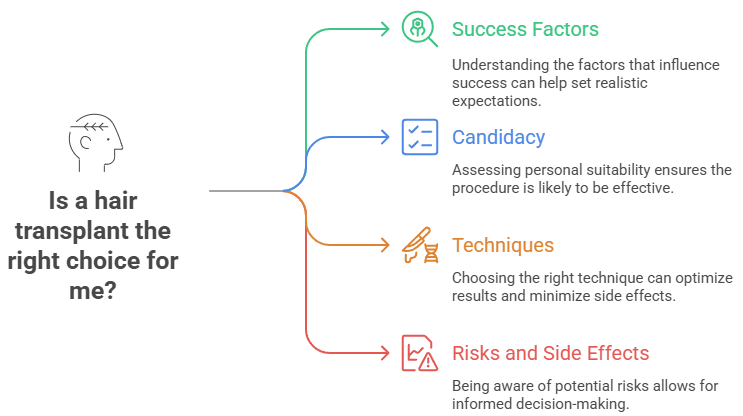Hair loss is a common issue, and it’s completely natural if you feel the need to restore your healthy head of hair. After you tried various options to no avail, you are now considering a hair transplant surgery, and let’s get straight to the point. You want to know one thing. Do hair transplants work? Yes, they do, but it’s not that simple. They work when done right, on the right candidate, using the right technique, and with a proper post-op regimen.
Today, we’ll examine what affects the hair transplant success rate, what impacts results the most, and what you can expect before and after your surgery.
Did you know?
According to the International Society of Hair Restoration Surgery, patients typically need only 1–2 hair transplant procedures to achieve their desired results, with the first session averaging more than 2,300 grafts transplanted. These numbers highlight how effective and predictable modern hair transplantation has become.
What Is a Hair Transplant?
Let’s ease our way into the article by understanding the definition. A hair transplant is a surgical hair restoration procedure that moves healthy hair follicles (microscopic structures that stimulate hair growth in the body) from one part of the scalp (typically the back or sides) to areas where the patient is experiencing thinning or balding.
After the recovery period is over, these follicles will continue to grow like normal hair. That’s the gist of it.
Do Hair Transplants Actually Work?
Successful hair transplant surgery leads to permanent, natural results. This is because the transplanted hair follicles are resistant to Dihyrotestosterone (DHT), the hormone that causes male pattern baldness, so your hair will keep on growing as you continue aging.
You’ve probably heard that some patients had bad experiences, but this is because several factors influence the outcome, such as your overall health, the extent of your hair loss, the surgeon’s expertise, the quality of your donor area, and so on. The good news is that reputable clinics boast an average hair transplant success rate of over 90%, which is very promising.
What Is Considered a Successful Hair Transplant?
The final goal of the procedure is not just to stimulate new hair growth, but also to make it look natural. It should feel dense and blend well with the rest of your hairline. Otherwise, it can end up looking awkward. For example, if the density is not correct, then no matter how much your hair grows, it won’t feel like a major improvement.
The most important signs that the procedure was a success are as follows.
- Your hair is growing consistently over time.
- The shape and growth direction of your hair look normal.
- The implanted grafts have a high survival rate.
- There is no major scarring or visible signs of surgery.
Who Is a Good Candidate for a Hair Transplant?
Your surgeon should determine this, but in general, hair transplants can help both men and women. However, the cause of hair loss must be diagnosed first. Those with diffuse thinning or scarring alopecia may need alternative treatments.
Here are some factors that make you a suitable candidate for the procedure.
- Your hair loss is stable and not progressing rapidly.
- You have a healthy donor area where the surgeon can extract enough follicles.
- You are in good physical health.
- You are well informed about the possible results and have realistic expectations.

Types of Hair Transplant Techniques
Depending on the state of your hair loss and your goals, you can go for three different options.
- Follicular Unit Extraction FUE: Individual hairs are extracted from the donor area and implanted one by one. This method leaves minimal scarring and is ideal for patients who are used to short hairstyles.
- Follicular Unit Transplantation FUT: Also known as follicular unit strip surgery (FUSS), this procedure involves removing a strip of skin with hair from the donor area and dissecting it into individual grafts, which may leave a linear scar.
- Direct Hair Implantation DHI: This is a special variation of FUE that uses a special implanter pen for precise angle and depth control. This procedure is geared towards hairline refinement and smaller areas.
Potential Risks and Side Effects
The procedure itself is quick and painless, but during recovery, patients can experience some minor side effects. Here are the most common ones.
- Temporary swelling or redness
- Itching or crusting at the recipient site
- Minor bleeding or discomfort
- Shock loss (temporary shedding of transplanted hair)
With improper post-op care, patients can also experience infections and swelling, but this is very rare.
Life After a Hair Transplant
The initial recovery is quick in most cases, and within a few days, you can return to normal activities. To keep it that way, you need to follow all the doctor’s post-op care instructions. You will learn how to wash your hair, and keep in mind to avoid direct sun exposure. You should also use special shampoos to protect the newly transplanted follicles.
Here’s how the timeline looks.
Timeframe | What to Expect |
Month 1 | Your transplanted hair will fall out, which is to be expected. |
Months 3–6 | You will notice new hair growth for the first time. |
Months 6–9 | Your new hair will become noticeably thicker. |
12 Months | You can experience life with a full head of hair. |
Finding the Right Hair Transplant Clinic
Before you commit, you should properly research the clinic. You don’t want to waste your time and money. Look for a surgeon with proven credentials, consider their hair transplant before & after photos, and make sure that their pricing is clear and transparent. Then, check for reviews and testimonials, and finally, see if they have post-op care available.
Your research will undoubtedly lead you to consider a hair transplant in Turkey. Clinics like MedHair offer customized plans using modern techniques with comprehensive aftercare help, all of which are key to a successful transplant.
FAQs
How long do hair transplants last?
Usually, they last a lifetime. The transplanted follicles are resistant to balding.
Do hair transplants look natural?
Yes, they do, as long as they’re done by skilled surgeons.
Will I need more than one hair transplant?
Sometimes, if hair loss continues in other areas, this can be a solution.
What is the success rate of a hair transplant?
It’s around 90–95% when done properly.
How soon will I see results?
Initial growth starts at around 3 months, with final results after 12 months.
